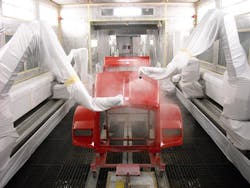Now, no one panic!
This isn’t the beginning of an ode to that 1971 classic movie Willy Wonka and the Chocolate Factory and the oddest of its characters, the Oompa-Loompas.
No, “Oompa-Loompa” imagery in this case is being used by David Ross, managing director of the transportation & logistics research group at Stifel Capital Markets, to highlight the importance of the “little things” going on in the trucking industry these days.
[And let it be known that Mr. Ross is becoming quite the comedian in freight transportation circles of late, following the popularity of the truck jokes he made at the expense of YRC Freight.]
In actuality, though these “little things” actually contain a lot of big ramifications for motor carriers large and small, such as: whether self-driving trucks will be deployed before self-driving cars; whether the current activity by the Teamsters indicates a revival of union fortunes in trucking or not; the ongoing trend towards more consolidation in freight transportation; and whether the recent uptick in truck equipment orders is indicative of an industry on the rebound.
[By the by, I’ll admit I got more than a little wigged out when I first saw these orange creatures with the green hairdos parading across my television screen, let me tell you.]
That’s a lot to digest, so let’s provide a few highlights.
A glimpse inside LTL segment dynamics: While most readers of this blog are not operating in the LTL space, Ross provided some very interesting analysis in terms of how to determine if market conditions are helping or hurting the bottom line of LTL operators. Here are a few:- Average length of haul (LOH): an increase in average length of haul increases revenue per hundredweight, as more compensation is required for the longer distance traveled. Not all of the LTL carriers disclose their LOH numbers, but among those that do, Ross said the average year-over-year increase is about 1.4%. That’s a good sign for freight.
- Average weight per shipment: Here’s an ironic twist to this metric; a decrease in average weight per shipment tends to increase average revenue per hundredweight (that’s a good thing) as heavier shipments typically fall into lower freight classes. Of the publicly-traded LTL carriers Stifel tracks, weight per shipment decreased, on average, 1.9% year-over-year last year in the third quarter. So the trend line is good there as well.
- Average freight commodity class: Essentially, greater freight density means lower average classification, and thus results in a lower-billed-revenue per hundredweight figure. Yet since LTL carriers do not report this metric, it can be hard to calculate, Ross noted. He assumes it’s been flat of late; however, a shipper classification known as “FAK” or “Freight All Kinds” can skew that data and impact revenues and profits. “For example, the parties might agree to an FAK of 77.5, but if the carrier were to monitor what is being shipped, it may find the average to be closer to 100 or even 150, which would mean the carrier is getting underpaid,” he stressed.
Do LTL carriers make or lose money on fuel surcharges? Again, while Ross addressed this from an LTL perspective, it’s interesting food for thought for all trucking companies. As for LTLs and fuel, Ross explained that the better the density (which means when fuel prices are rising) the more money they can make on fuel surcharges.
"The better the fuel economy of their equipment, the more money they make by saving on fuel expenses," he added. "The better their purchasing, the more money they make on fuel. The fewer “fuel caps” they have in contract, the more money they make on fuel. The fewer alternative surcharge tables (for example, Walmart has its own fuel surcharge tables the carriers use) the more money they make on fuel. The more favorable their regional fuel costs versus national highway diesel average, the more money they make on fuel."
Of course, Ross stressed that fuel price declines create to opposite impact; indeed, YRC Freight recently told him that fuel is now a slight tailwind in 2017. But based on what he is seeing now, though, fuel surcharges should begin to help LTL carrier results in 2017 after being a headwind the last couple of years.
What’s up with the strong Class 8 orders? One would think the surge of Class 8 orders over the last few months would indicate improving fortunes for trucking, but Michael Baudendistel, vice president of Stifel’s transportation & logistics research group, that even though he’s boosted his truck equipment forecast for 2017 and 2018 what we’re experiencing is actually a return to more “normal” season order patterns.“Last year, and even more so the year before, when backlogs were still extended, there was more incentive to get orders in early in the order season, which led to very strong October-December numbers and then steeper drop-off as we got into January and beyond,” he explained.
“This year, with backlogs normalized – and also with some delay in orders in October and November due to uncertainty around the election and the general freight economy – orders returned to more normal seasonal patterns. So, while fourth quarter 2016 orders in aggregate were steeply negative, January and February were sharply positive,” Baudendistel emphasized.
“A lot of that is just timing. But, there also has been some definite strengthening, as you would normally expect orders to decline in February from January," he added. "Since that did not happen this year, confidence appears to still be growing.”
Consolidation will continue in transportation: Brad Jacobs, the CEO of XPO Logistics, noted in a recent speech that there is “only more consolidation ahead” in freight transportation, especially in the ocean shipping industry, though XPO won't be buying any steamship lines any time soon. Mergers are difficult but “worth it” in his opinion though they need to be done quickly and accurately to work properly, which is easier said than done and “which is why most fail to achieve desired results.” Jacobs added, however, that “merging cultures” is the more difficult part, with a need to really understand the culture and not expect to change it.
[Editorial note: more on the topic iof "trucking culture" to come in a future post.]
“It’s kind of like marriage; you don’t really know who you got until six to 12 months after the honeymoon,” he said.
Are the Teamsters reviving unionization in trucking? Ross doesn’t think so and uses the Teamsters’ recent organizing activity against XPO as an example. Out of 300-plus terminals at XPO Freight, the Teamsters have managed to organize three – Miami Lakes, FL; Laredo, TX, and Vernon, CA , which is South Los Angeles – and that’s from back when it was Con-way Freight. Since the acquisition, the Teamsters have organized a couple more XPO warehouses, but that still represents only a small fraction of XPO’s total workforce and facilities.“XPO is certainly a target now due to its scale as the Teamsters have been going after Wal-Mart and FedEx for years, with virtually no success,” Ross said.
“But they [the Teamsters] like to chase deep pockets, which is a main reason Amazon is doing everything it can to maximize use of independent contracts and third party usage, in our view, as it grows its transportation footprint,” he added. “Yet these unionization efforts are not new and therefore [are] known risks. Moreover, unionization is not an easy task [as] drivers and workers are not always keen to pay dues. Even in California, there were three terminal votes, and only the Vernon facility went union by a narrow margin.”
How soon will robot trucks start rolling on our roads? Stifel’s John Larkin believe freight transportation “will be among the last industries [to be] automated, given the complexity of hauling freight on mixed-use guideways,” he said. “This will make capacity even scarcer, as companies will struggle even more to find incremental drivers to pilot incremental vehicles to handle the incremental demand from the re-shoring of manufacturing that is economically enabled by automation/robotics. The best drivers will shift to the energy and construction industries, if the above scenario fully plays out."
What isn’t fully developed yet is whether self-driving trucks are deployed onto U.S. roads first, ahead of self-driving cars, or the reverse occurs. One Stifel expert believes fully autonomous vehicle (AV) technology is five years away from practical introduction, with self-driving cars hitting the road in 10 years and 15 or more years before it reaches commercial trucks. Yet another expert thinks trucks may beat out autos as dedicated linehaul could be the “best first” opportunity, relatively speaking, for self-driving vehicle. “They offer predictable, repeatable routes, lots of easy highway driving, and they stay out of congested city centers and away from pedestrians,” this expert noted. “Plus, commercial operators will be more willing to look at the economic analysis pragmatically than consumers, whereas the consumer benefit is more convenience and accessibility.”
Wow. That’s quite a data dump from the “Oompa-Loompa” files if you ask me. We’ll return to those files later to see how these observations may be altered as we head into the springtime flow of freight.






